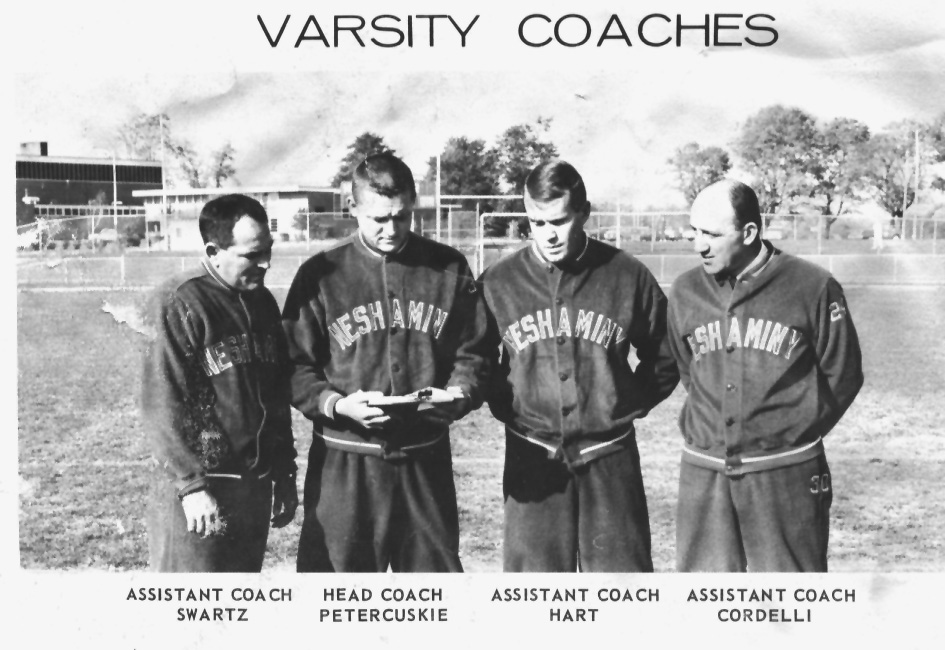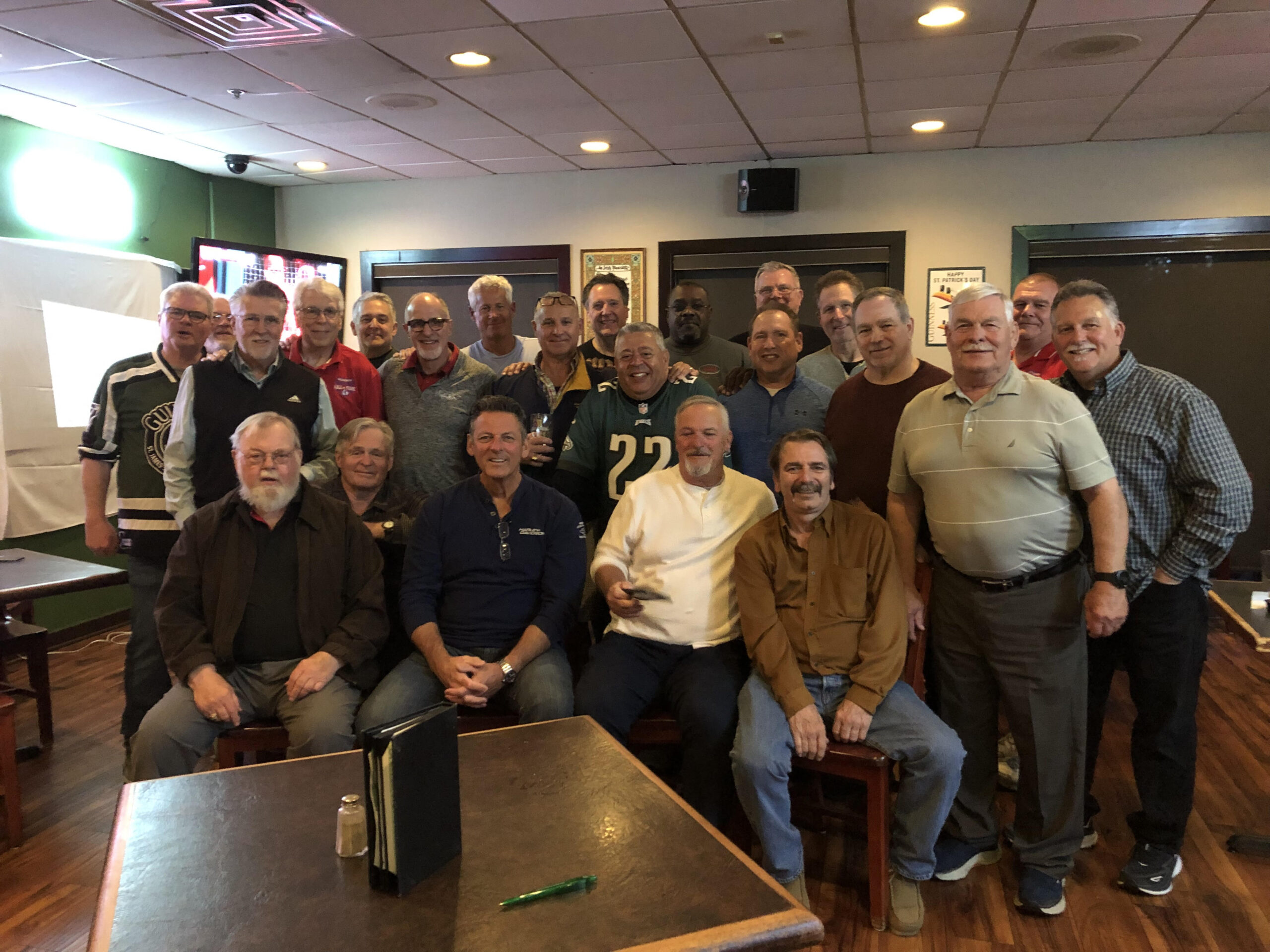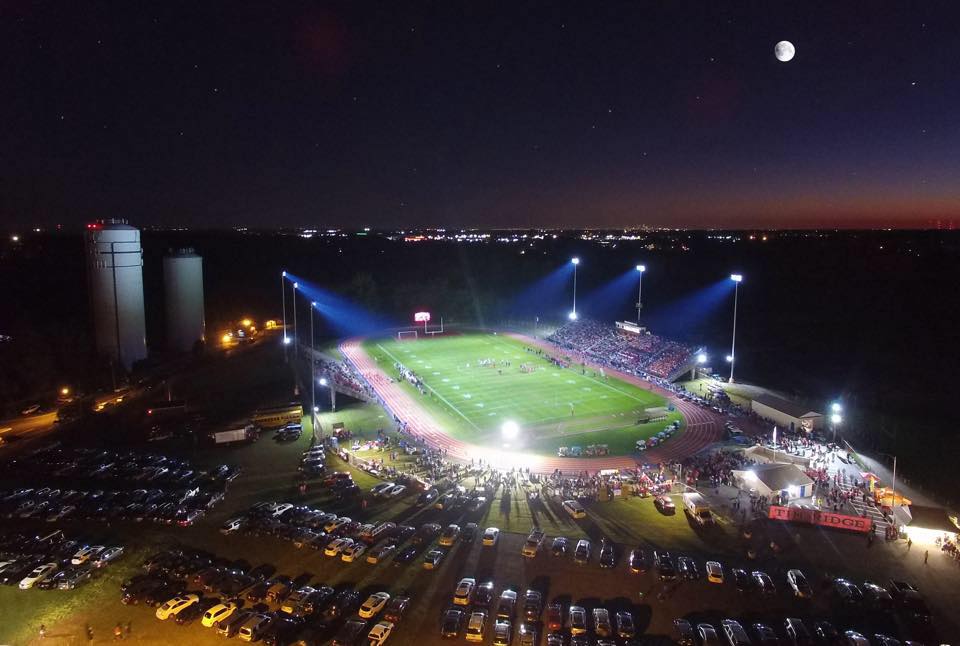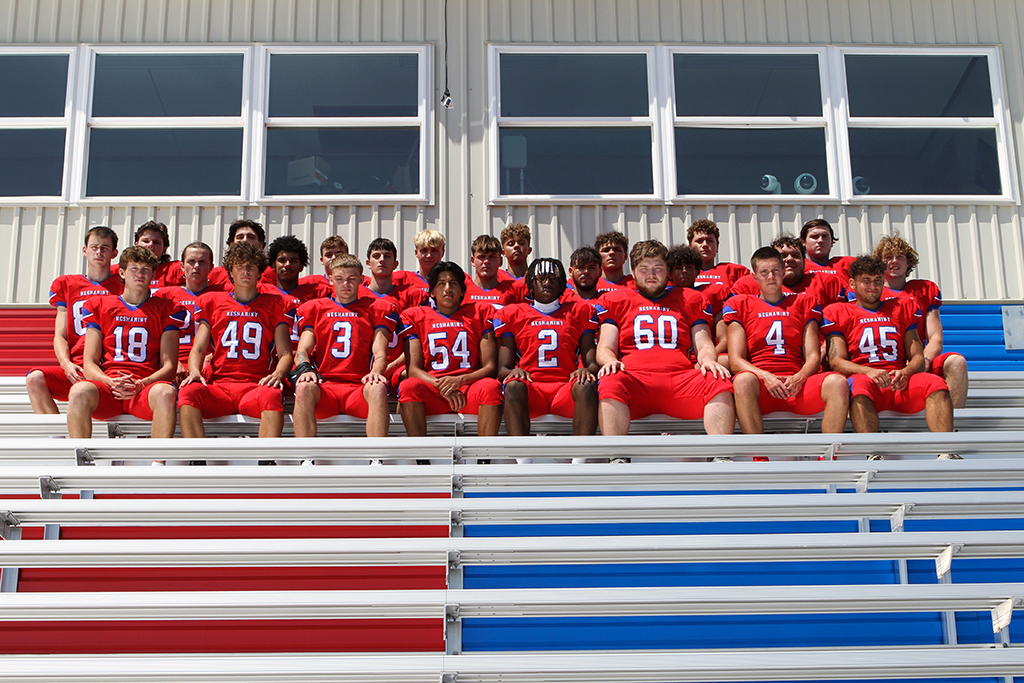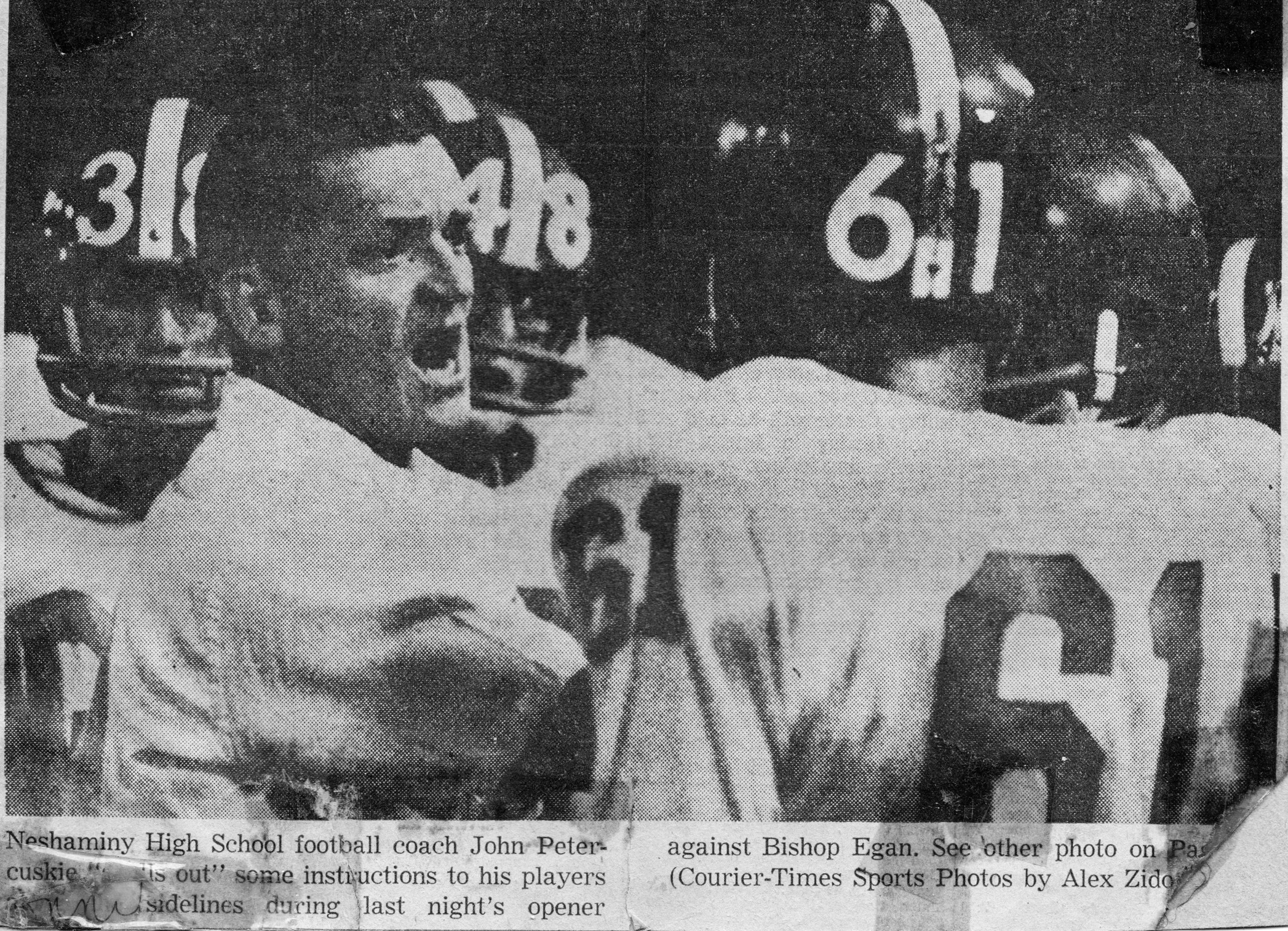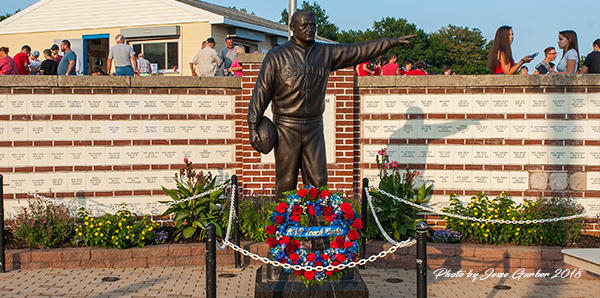Harry E. Franks and the ’50s
Harry Franks
The Father of Neshaminy Football
It was a time when giants first walked the earth of a small town in Bucks County. They had names like Faunce, Cloak, Conroy, Cummings, Moronese, Cameron, Stricker, Schuh, Covington, Fisher and Rumsey. It was also a time when great men named Petercuskie, Swartz, Allison, Cordelli and others would descend on that same community to forge steel out of the bones, muscles and sinews of the young men who became those titans.
It was a time when a senior high school’s competence on the gridiron would change from occasional displays of greatness into season after season of championships. It was a time when its opponents would shift from neighborhood rivals to regional powerhouses and a schoolboy football dynasty would be established that still flourishes to this day.
It was the 1950s. It was the beginning of the Golden Age of Neshaminy High School football – a period that would last for over two decades. And its grand architect was a man whose powerful shadow and dominant personality still cover those who follow in his footsteps and play in his stadium.
His name is Harry Franks. This is his story.
Reading, Pennyslvania Builds the Man
Growing up in Reading, Harry Franks came from a large family of nine children. Despite the “size” of the Franks’ household, they were a close knit group that would always be an important part of each others lives. And with Franks’ Dad involved in sports − including owning the local minor league baseball club – it was only natural that young Harry would first find his way in the world as an athlete himself. Excelling at baseball and soccer in his sophomore year at Wilson High (now Wilson West Lawn), he looked ready to become a star; however, household finances and a national economy beyond his control thrust more important obligations on the young Franks. Accordingly, he left school for work in the mills of Reading after the tenth grade to help provide for the family that was in need of his help.
Then, as if a world economic situation didn’t demand enough of him (and as was the case with many men of his age at that time), Uncle Sam also asked for his help as World War II erupted into its full fury. Answering the call, Franks soon found himself in the Marine Corp where he was to serve a four year hitch.
But the poor economy and global war eventually ended and Franks then found himself back home in Reading. Picking up where he had left off − now at an accelerated pace − Franks finished two years of high school in just months. With college studies and a career in teaching on his mind, Franks went off to East Stroudsburg State for the next few years as he pursued a Bachelor of Science in Education. And as an aside, while earning his undergraduate degree, Franks befriended a fellow ex-Marine attending school, and playing football, at “State” by the name of John Petercuskie. It was a friendship that would blossom and grow in more ways than the two young men could possibly imagine when they first met.
Maintaining a full dance card, during college Franks found time to work at the Ronson Lighter Company in East Stroudsburg while also serving as an electricians’ helper for the Fred Waring Band and Choral Group which was a centerpiece of the popular culture of the area (Franks still helped provide for his family and the two jobs served that goal). In addition, Franks spent Sundays playing semi-pro football (his introduction to the sport) for a number of “clubs” including the Glenside Bulldogs, the Franklin Football Club, Genzell’s Green Jackets and the VVVs. Just as was the case with his new acquaintance, Petercuskie, Franks was as yet unaware of how the sport of football would eventually play such a large part of his life.
Meanwhile, with nary a spare moment available to him, Franks’ time at East Stroudsburg soon came to an end. Barely pausing for a breath, he took a sales job with the Curtis Publishing Company of Reading while commuting to Philadelphia and Temple University to secure a Masters in Health and Physical Education. Once again, time flew and by 1951 Franks had completed his schooling and was ready for his calling as a teacher and coach. Hearing of an opening for a position in sports and teaching at his high school alma mater, Wilson, he applied for the job. One of the final two men in the running, Franks was passed over − fortunately for another school district as would be revealed. In fact, he quickly learned of that other school in Lower Bucks by the name of Neshaminy High that was looking for a teacher and a junior varsity football coach too. Bidding for both openings, this time Franks landed the positions.
Also, although not yet known, 1951 would come to be seen as the time when the foundations for several of Franks’ most enduring relationships were put in place.
Langhorne and Neshaminy Welcome Franks
Arriving in Langhorne with all the shine and promise of a newly minted silver dollar, that first year at Neshaminy was to prove to be prophetic for the now Coach Franks. A machine shop fit, Franks settled nicely into his teaching role while he also directed his junior varsity Redskins squad of that year to an unblemished 7-0-0 record (which was a sign of things to come for those ninth graders as they would later prove in 1954, their senior year). And as if that wasn’t enough, Coach Franks also spied an attractive and charming, young music teacher at Neshaminy by the name of Joan Mattern. With fortune surely smiling on him, Harry and Joan “hit it off” and Ms. Mattern became Mrs. Franks the following year.
Then as if following a pattern, as 1952 rolled around another opportunity presented itself to Franks as the head football coaching position at a nearby high school, Pennsbury, opened up for applicants. Ironically, among those competing for the job with Franks was Jim Egli who was Neshaminy’s head coach at that time. As it turned out, Egli was hired for the job and with the Redskins suddenly in need of a head man for its varsity grid squad, Franks was moved up to the position. With the stage now set, the time had arrived for Franks to fulfill his destiny as the man who would be credited with building the Redskins football program into what it is to this day.
Starting with a clean sheet of paper, Franks designed an offense from the ground up modeled on the single wing as then run by the Princeton Tigers (Franks had developed a friendship with the Tigers’ head man and after a few skull sessions, the single wing would be Neshaminy’s for the next 12 seasons).
Meanwhile, on the field Coach Franks also started with a clean sheet of paper as players were told that all positions were open to the highest bidder. No slouch as a conditioning master, by the end of that first summer of two-a-day practices just 19 candidates remained. And what a group they were, for after losing the opener to Ambler (call it first-game jitters) the 1952 ‘Skins reeled off 9 straight wins to close out Franks’ first season at 9-1 (the best Redskin season record up to that year). Not missing a beat, that effort was followed by the 1953 season which saw the Tribe win their first 9 in a row before Bensalem upset the Langhorne boys, 7-6, (it was to be Bensalem’s last win against the Redskins for some 20 years) as Franks’ charges posted their second straight 9-1 record.
Hitting their stride, next up was the 1954 club − a team that would go down in the annals of Neshaminy history as one of its greatest. Paced by Errol Faunce, Don Cameron, Earl “Shorty” Moronese and a host of others, the Redskins of that year would finish the season 10-0-0 while scoring 349 points and yielding just 83 (the offensive output was a then Lower Bucks record with that nearly 35 point a game average quite a feat in those days of lower scoring teams). All in all, Franks’ first three years saw his clubs go 28-2.
Not resting on their laurels, over the next 5 years (through 1959) Franks’ Redskins would continue to deliver on the field as they fashioned a 41-8-2 record. Two standout seasons in that group were the 9-0-1 1956 team and the 1959 group that was tagged just once as they finished 10-1 (that one loss was to the defending Pennsylvania state champs Easton, 13-7, with Neshaminy giving up a score − and the lead − with just seconds to go on a “Hail Mary” pass play by the Red Rovers). And so it wouldn’t be said that the Franks coached clubs simply overwhelmed the local competition, he aggressively scheduled the toughest and best high schools throughout eastern Pennsylvania and New Jersey (no matter, though, as Neshaminy’s dominance on the gridiron was unquestioned).
Finally, with his transformation of Neshaminy football complete, in 1960 Franks handed the reins to John Petercuskie (whom he had brought onboard as an assistant coach in 1954) and retired with 8 straight LBC titles under his belt. His accomplishments on the field unchallenged, Franks’ final overall record came in at 69-10-2 which, to this day, is second only to Petercuskie’s 59-1-5 record when considered from a winning percentage standpoint. And although his day-to-day head coach responsibilities were behind him, equally important tasks still remained.
‘Skins Athletic Director and Maple Point
Following his last year as head coach of the Redskins football team, Coach Franks became Mr. Franks again as well as Neshaminy’s Athletic Director and Administrator of Co-Curricular Activities too. Holding that position until the mid-70s, he rode herd over Neshaminy’s diverse and successful athletic program and many of the schools other activities (in fact, it was Franks who had started Neshaminy’s long running and still very popular “Gym Night” student sports spectacular in the mid-1950s).
Always keeping his eye on the football squad’s accomplishments, he was instrumental in keeping the program at the top of its form during his tenure as the AD. Watching from the top spot, Franks had a bird’s eye view of not only Petercuskie but Pete Cordelli, Sr., Jack Swartz and Pal Allison as they all had their opportunity as the head coach of the ‘Skins as well (and they were all Neshaminy coaches in the first place due to Franks’ ability to spot talent on the field and in the coaching box too as he had brought them all into the program during his tenure as the head man during the 1950s). Supporting that thesis, those four men had a combined coaching record of 122-35-6 during the 15 years they collectively bossed Neshaminy’s grid clubs. That’s a winning percentage (without the ties) of just about 80%. Factoring in Franks’ 69-10-2 record, simple math then reveals that his contribution to the school is 23 years of glory as demonstrated by the group’s overall record of 191-45-8 (just about 81% to the good side over almost a quarter-century).
Then in the mid-70s when the Neshaminy brass decided two schools were needed to serve the District and its growing population, it was Franks that was given the job of creating a brand new sports program from a cornfield in the farm area northeast of Langhorne. Thus it came to pass that Franks would guide Maple Point High School during it’s 8 years of life as he relied upon the same philosophies that had brought Neshaminy’s athletics to the top of the heap. And as evidence he hadn’t lost his Midas touch, his new football coach was John Chaump who would not only forge a winner out of the Cougar’s teams but later − in the 1980s − it was Chaump that helped resurrect the Redskin football program after it had suffered a few moribund years. In fact, Chaump’s 1988 ‘Skins team not only finished 11-0-0 (the third “perfect” team in the school’s history) but that year’s club participated in the first PIAA statewide playoff. Chaump also remained active in coaching until the mid-2000s as the defensive coordinator for Head Coach Mark Schmidt’s juggernaut clubs of the new millennium – an exclamation point on the influence wielded by Franks on the Neshaminy program.
Constantly motivated, and believing in “giving back” too, it should be pointed out Franks also started and then headed the Lower Southampton Recreation Association from the mid-50s until 1963. Considering the number of young Redskins who grew up participating in that program it’s no wonder that the football teams − as well as many of Neshaminy’s sports teams − were so dominant during that time. And no slouch in the classroom, Franks undertook advanced studies in academia throughout his career with course work at Temple and Lehigh Universities as he secured certificates in a number of areas crucial to his chosen field of education (in fact, Franks was within a whisker of earning his doctorate before the time constraints of his many endeavors prevented taking some final credits).
The Imprint
If there is one man that might be permanently wreathed with the title “Mr. Redskin” it would be Harry Franks. Taking the helm of a small club team that had first played football less than a quarter century before he arrived, Franks quickly took the program to the top of the class. Then along the way he hired the men that would still be exerting influence on the field over a half-century later. Always the innovator, and among so many other things, Franks instituted the team’s awards programs which honor each year’s “best” players, built the new football field in 1956 and then had the concrete stands installed in 1960. Modifying its uniforms to fit the times, he also expanded the quality of the schools on Neshaminy’s schedule while he was instrumental in the creation of the LBC Section I and II leagues in addition to the East Penn League which later became the Big 5. And perhaps most importantly, it was Franks who penned and gave Neshaminy High School those simple and stirring words:
-Time will never dim the glory of the Neshaminy Redskins-
Finally retiring in 1983 after providing over 30 years of unwavering and unselfish service to the Redskin family, Franks’ contributions did not go without notice when, in 1985, the Neshaminy School District appropriately renamed its athletic venue in his honor as Harry E. Franks Stadium. Additionally, Franks’ name was the first to be lauded when he was included in the inaugural class of the new Neshaminy High School Football Hall of Fame that same year too. And with time now serving as the looking glass, it couldn’t be clearer that the Neshaminy football program of today is a direct result of the work, vision and guidance of the man who towers above all others as a giant among Redskin giants − Harry E. Franks.
